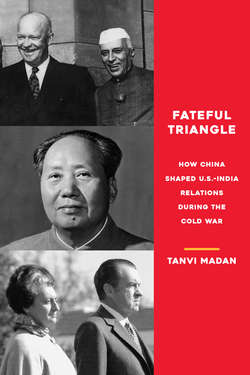Читать книгу Fateful Triangle - Tanvi Madan - Страница 25
На сайте Литреса книга снята с продажи.
US-Pakistan: Collective Security or Creating Insecurity? (1953–1954)
ОглавлениеThe US would have liked to see India as part of its evolving collective security plans. Dulles was even willing to consider including nonaggression principles—of the Sino-Indian Panchsheel sort (discussed later in the chapter) that some were arguing for—if it would bring India and Burma into SEATO.70 The Joint Chiefs of Staff, on their part, wanted to exclude India and focus on the Pacific.71 But the State Department considered, with Eisenhower’s approval, the idea of organizing a smaller group on military matters and another on economic development that could attract states like India.72 Defense Secretary Charles Wilson thought Britain and India should take the initiative for any Southeast Asian consortium.73 Wilson and National Security Adviser Robert Cutler favored an Asian economic grouping more than a US-sponsored military one, but Dulles thought the US had come too far to jettison the latter.74 The US eventually dropped the idea of a dual-track group since neither Japan nor India were joining, and nonaligned countries were unlikely to participate in an economic grouping associated with the military treaty.75
Nehru’s general belief that pacts “brought insecurity” meant he had no interest in SEATO.76 He told parliament that the motivation for its creation—to ease the fears of countries in the region—might be good, but the approach was wrong.77 It could only be seen as anti-China, he said at the Bogor conference that preceded the Bandung summit.78 Nehru disagreed with the American view that China posed a clear and present danger in Southeast Asia. In another instance of mirror imaging, he told American ambassador George Allen that China did not have aggression on its mind; rather, like India, China wanted peace so that it could focus internally. Moreover, he disagreed with the Eisenhower administration’s military approach, arguing that it increased rather than alleviated insecurity. He stated that the US should accept Chinese assurances that they would not indulge in aggression and, in turn, assure Beijing that it would not try to invade China or overthrow the communist regime. In what had become a familiar retort, however, Allen argued that, given its apparent expansionist tendencies in Korea and Indochina, China needed to reassure the US first.79
While India had no interest in SEATO, its neighbor Pakistan did. News of Pakistani negotiations with the US for military aid, which began in spring 1953, had become public in November 1953. Subsequently, in February 1954, the US had confirmed it would provide military aid. A few months later, Pakistan offered to join SEATO, and US policymakers reluctantly accepted.80
There was an outcry in India against the inclusion of Pakistan in the US strategic script.81 Nehru called it an “intrusion of a new and dangerous element in the politics of Asia,” one that required an Indian policy rethink.82 Nehru told the home minister that the US would likely play a restraining role on Pakistan vis-à-vis India because “such a conflict would upset their larger plans in Asia.” But he was extremely anxious about Pakistan’s increased access to military equipment and the implications for Indian defense expenditures.83
Had India’s China policy affected the US decision to ally with Pakistan? Robert J. McMahon has argued that “American disillusionment with and devaluation of India” was definitely “a necessary precondition” for it.84 That devaluation had partly stemmed from India’s lack of willingness to play the role vis-à-vis China that Washington had hoped it would. The role it had played had not been helpful. The disillusionment, too, partly flowed from what US policymakers saw as India’s lack of understanding of the China threat and the American approach toward China. Beyond Delhi’s willingness, questions about India’s ability to stand up to China also contributed to the decision to go the collective security route. The idea of alliances and partnerships in the region itself partly stemmed from the belief that while India and Japan were potentially considerably strong, at that point, as the NSC statement of policy on China noted, they lacked the ability to resist the communists effectively. Thus noncommunist Asia needed “protection against Communist attack.”85
